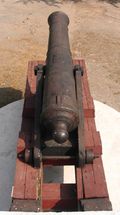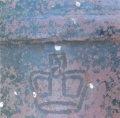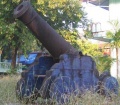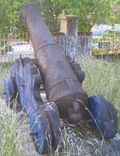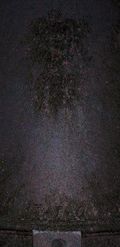British Guns in Burma
| This article describes British and other artillery pieces found in Burma after the 3rd Burma War. See also article Historic Guns of British India. The information and images have been provided by Elizabeth Hancox, a FIBIS member with a special interest in artillery, the Anglo-Burmese Library and the Royal Asiatic Society. |
Guns found at Mandalay Palace

From Mandalay the Golden by E.C.V. Foucar pub:1963. Image by kind permission of the Royal Asiatic Society.
The Pair of Guns at the Entrance
For the wind is in the palm trees, and the temple bells they say:
"Come you back, you British soldier; come you back to Mandalay!".
from 'MANDALAY' by Rudyard Kipling
- widths="330px"
-
Palace entrance gun 1
Image courtesy of the Anglo-Burmese Library -
Palace entrance gun 2
Image courtesy of the Anglo-Burmese Library
These two guns are similar but cast by different foundries. They are Royal Navy cast iron smooth bore muzzle-loading cannon, as are the pair at the exit, and they bear the Crown and 'P' signifying they have passed proof, that is to say been test fired, and they are stamped with the Royal Cipher of George ll (reigned 1727-1760). One gun has a weight of 57cwt 0qrs 8lbs (cwt = hundred weight = 112lbs; qrs = quarter = 28lbs). The other gun would seem to be of very similar weight. Both are 32-pounder demi-cannon of nine and a half feet.
- widths="150px"
-
Palace entrance gun 1 detail 1
Image courtesy of the Anglo-Burmese Library -
Palace entrance gun 1 detail 2
Image courtesy of the Anglo-Burmese Library -
Palace entrance gun 1 detail 3
Image courtesy of the Anglo-Burmese Library -
Palace entrance gun 2 detail
Image courtesy of the Anglo-Burmese Library
Palace entrance gun 1 was cast at the Waldron foundry near Heathfield in Sussex, at the time of John Harrison, Ironmaster. It is marked W on the trunnion which is the short iron protuberance each side which balances the cannon on the gun carriage enabling it to be tilted as necessary.
Palace entrance gun 2 was cast a short distance away at the Heathfield foundry by John Fuller (marked JF on the trunnion). This trunnion mark was used between 1722 and 1745.
Gun founders were a tight-knit community, often inter-related, and were in the habit of sub-contracting work to a neighbouring foundry if they were over-committed with orders. This may well have happened with these two cannon.
The question that we all want to know, of course, how did these two pairs of Royal Navy cannon find themselves guarding a Burmese potentate's palace in Mandalay ?
The Pair of Guns at the Exit
Gold is for the mistress, silver for the maid
Copper for the craftsman cunning at his trade.
"Good!" said the Baron, sitting in his hall,
"but Iron, Cold Iron, is master of them all."
from 'COLD IRON' by Rudyard Kipling
- widths="330px"
-
Palace exit gun 8009
Image courtesy of the Anglo-Burmese Library -
Palace exit gun 8012
Image courtesy of the Anglo-Burmese Library
These are the oldest Royal Navy guns seen. They are marked with the Rose & Crown insignia which was used by the Board of Ordnance from 1690 to 1725. The design of the crest varied slightly as the years progressed. The guns are marked respectively 8009 and 8012 and the marks on the buttons are L7 and S11. These last refer, I believe, to the guns' position on board ship, Larboard No.7 and Starboard No.11. The word Larboard was subsequently changed to Port to avoid confusion. The serial numbers are recorded in Col. Browne's Survey and refer to a date of 1695. From this survey it can be established that they are nine and a half foot 32-pounder demi-cannon, cast by Thomas Weston, Ironmaster of the Ashburnham forge near Battle, East Sussex, for HMS NEWARK. She was a Third Rate ship of the line mounting 76-80 guns of various weights.
- widths="150px"
-
Gun 8009 detail 1
Image courtesy of the Anglo-Burmese Library -
Gun 8009 detail 2
Image courtesy of the Anglo-Burmese Library -
Gun 8012 detail 1
Image courtesy of the Anglo-Burmese Library -
Gun 8012 detail 2
Image courtesy of the Anglo-Burmese Library
Each of these 32-pounders would be serviced by 14 men and a 'powder monkey' (a small boy who could easily run up and down ladders carrying bags of gunpowder from deep in the ship's hold). HMS NEWARK was refitted in 1717 and in 1745. At each refit, and possible alteration to the ship's hull, it was usual to remove and assess which guns would still be needed. Those surplus to requirements, but still in good condition, would be transferred to the ordnance stores and placed on another ship as needed. Well founded cannon, if used with the correct amount of powder, single-shotted and not fired at extreme elevation, could be expected to last 1000 firings and a few were recorded as lasting for 3000 before becoming worn out and useless.
Tracing the History of the Guns
THEY SEEK 'EM HERE, THEY SEEK 'EM THERE,
THOSE BURMESE SEEK THEM EVERYWHERE,
ARE THEY IN HEAVEN OR ARE THEY IN HELL?
THOSE DEMMED ELUSIVE CANNONS AND SHELLS!
With sincere apologies to Sir Percy Blakeney, the Scarlet Pimpernel, and his creator, Baroness Emuska Orczy, for this parody of the well known ditty.
The first official and knowledgeable recognition of these guns was made by an officer of the Queen's First Royal Artillery, Major Hewitt who, with his battery of 100 men had been detailed off to find and report any armaments he might discover in Mandalay and the surrounding area at the conclusion of the Third Anglo-Burmese War in 1885.
On 23rd January 1886 he noted a gun emplacement on the south embankment of the Irrawaddy, 6ft. higher than average, mounted on a platform with a centre pivot and a 32pdr. smoothbore muzzle-loading cannon lying beside it. Major Hewitt was to capture five more of these cannon mounted on traversing platforms in the Palace enclosure, so in total there must have been six, although the whereabouts of the remaining two have not been noted. (IOLR L/MIL/17/19/30)
Burmese of the Konbaung dynasty were constantly endeavouring to acquire armaments, especially cannon and all the necessities for servicing them, but they lacked officers skilled in such matters. Officers of any European nationality who visited Burma and knew anything about weapons were promptly kidnapped, promised land, a house, an allowance of money and a Burmese wife if they settled down peacefully in the King's service, which many did. That generation of gunners gradually died out and in consequence of neglect and the effects of the climate iron cannon deteriorated quite quickly. Some were never fired at all, but in the reign of King Mindon (1853-1878), who moved the capital from Amarapura to Mandalay, an over-zealous Burmese commander of artillery exercised the great guns on the plain near the Palace, but the thunderous noise so disturbed the King and worse, quite unnerved his many Queens and his numerous offspring that he immediately gave orders for the practice to end. All cannon were to be brought into the enclosure, aligned in front of the Palace and gilded, where they looked magnificent and served a merely decorative purpose. (“Mandalay The Golden” by E.C.V. Foucar – pub. London 1963)
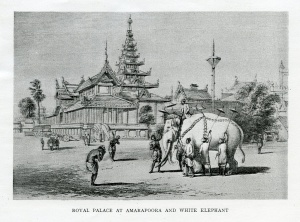
Note the pair of 32-pdrs in front of the palace entrance
From Europe and Burma by D.G.E. Hall. Pub.1943
Image by kind permission of the Royal Asiatic Society.
King Bodawpaya (1782-1819) moved the capital from Ava to Amarapura for fear that evil spirits might cast their spell over that place in consequence of all the royal blood spilled in his struggle for the succession. There were always many contenders for kingship because of the royal family's habit of marrying plenty of half-sisters. Bodawpaya took possession of his new Palace on 10th May 1783 and having settled in he set out to conquer the Arakan, making that state a province of Burma in 1784, acquiring a motley collection of weapons in the process, many of them rusty, including the enormous locally made cannon (see Mandalay Monster below). Next he determined to inflict a decisive blow on his neighbours the Siamese, Burma's traditional enemies, and for his campaign to succeed he would need all the arms he could get hold of. In consequence he wrote in 1786 to Mohammed Syah, Sultan of Achee, Sumatra, but without result, so he tried again in 1787 with a letter to the French Agent in Chandernagore, but their enclave was in the uncomfortable position of being too close to the British in Calcutta who regarded them with deep suspicion and had the most annoying policy of applying 'stop and search' in respect of every French ship passing Fort William and entering the Bay of Bengal, removing important letters and secret papers intended for French eyes only. Bodawpaya had also approached the Governor of Pondicherry in the hope of engaging in trade. He had even sent him 'un petit batiment' (in nautical terms 'a small vessel') laden with three elephants by way of inducement. One can only imagine the astonishment of many a passing ship's captain who must have doubted their look-out's eyesight and sobriety, and quite possibly their own as well. It is not related whether or not the gift was appreciated. (From Les Relations entre la France et la Birmanie au XV111 siecle et au 1X siecle. - Pierre Preschez Paris 1967.)
The King, meanwhile, was actively encouraging the use of the southern port of Mergui by French pirates and privateers, exempting them from port dues and allowing them free food and lodging. The Indian Ocean was beginning to be overrun with freebooters and worrying reports were coming in from various sources warning of trouble ahead.
In IOLR I.1/17, a collection of letters and papers concerning French activities in the area, there is a note written in 1794....”trade entirely at a standstill for want of protective ships against French privateers operating out of Mauritius”....and in I.1/12, also a collection of papers and intelligence reports, Lt.Col. Robert Brooke wrote to Calcutta from St.Helena in 1794....”It is stated as a certainty that the people of Mauritius are so intoxicated with success in taking prizes that they are mad with fitting and arming vessels against the English and the Dutch trade, with expeditions against those parts of our coasts that are unprotected. Several American ships are hastening home from thence after purchasing the cargoes of various prizes to return again, with additional swarms, to get more bargains and to supply the French islands with naval stores and adventurers, so that if left undisturbed they may get so strong that it would require a very powerful force indeed to subdue them and in the meantime the English and Dutch trade may suffer inconceivably....the French are fitting 18pdrs. aboard the Dutch prize as well as the PRINCESS ROYAL (Indiaman) and hope to make her above 50 guns.” (This vessel and her Packet had been captured in the Straits of Sunda, between Sumatra and Java, by French privateers.)

(From Wikimedia Commons)
Bodawpaya had also written to Mauritius which finally produced a positive reply to his request for arms. The Governor, Anne Joseph Hippolyte de Maures, Comte de Malartic, stated that he could not at that time comply with the requirements because of the ongoing war with the English (1793-1815) but promised to supply all that was wished for as soon as circumstances changed. This Governor died in 1800 and the new incumbent, Generale Francois Louis Magallon, Comte de la Morliere, decided to honour his predecessor's intentions and sent to Burma two cargoes of armaments, including cannons, in 1802 together with a letter promising a new load of warlike munitions if the King so desired.
The East India Company was, at the time, attempting by means of Special Envoys sent from Calcutta with the usual gifts, to persuade the Burmese King to enter into an agreement to close his ports to French warships and to negotiate a commercial treaty with the Company's Agent residing in Rangoon. This, Bodawpaya refused to do. He wanted to obtain guns and knew the British were suspicious of his motives after his army's arbitrary incursions into Chittagong and the protectorate of Manipur, and would certainly not supply him with those heavy guns which he craved. On the other hand, although their power and influence was on the wane, the French were hoping to keep their options open, just in case, since Burma was the source of many valuable commodities and good relations might provide benefits in the long run.
Pierre Preschez says that two ships, the VILLE DE LYON and the GEORGE , said to be prizes taken from the British, laden with cannon and muskets were despatched from the Ile de France (Mauritius). The former arrived in Rangoon on 27th March 1802, but the latter mistook the port and was wrecked at the mouth of the River Sittang.
Capt. Michael Symes of HM 76th Regiment, in the Journal of his second embassy to the Court of Ava in 1802, elaborates, and also gives a different month of arrival:-
“.....on the 27th of last month (i.e. July 1802) a ship from the Mauritius anchored in the (Rangoon) river. She is now called the VILLE DE LYONS, but was formerly the FREDERICK NORTH, an English ship which the French captured in the west of India. This vessel sailed from the Mauritius early in July in company with another called the GEORGE, also a capture made by the French, and parted with her consort at the Nicobars. On 29th July, two days after the arrival of the VILLE DE LYONS, accounts were received that the GEORGE had missed the port of Rangoon and been carried to the eastward where she went aground and was totally lost on the sands near the Sittang River. The crew escaped in their boats but the vessel and property were irrecoverably lost. A principal part of the lading of these vessels consisted of firearms which were expected by the Berman government and had previously been commissioned. There was likewise a letter from the Government of Mauritius to the Burmese monarch.”
On the 16th October Michael Symes notes “I received information from a Portuguese named Anthony George in the service of Baba Sheen (an Armenian who acted as agent for the East India Company in Rangoon) that Mr. Bevan, an American, but of French connections and, I believe, part owner of the French ship, had made protestations before a magistrate at Rangoon that on board the wreck there were considerable presents for the King of Ava from the Government of Mauritius and that amongst other things lost were ten pieces of ordnance and a quantity of muskets, some for sale and others as presents.”
In a letter dated 9th August 1802 to Lord Wellesley, Michael Symes writes that “The VILLE DE LYONS a fine ship of 500 tons.....and we heard that the GEORGE a still larger vessel and carrying a more valuable cargo of firearms on board the wreck... the rest of their cargoes were made up of the plunder of English ships which had been captured at different periods and carried into Mauritius, and since the ships came an air of mystery and an apparent wish to conceal or disguise something have been visible.” (European Manuscript Add.13872).
This still leaves the question of the provenance of the cannon. There was an American supercargo on the GEORGE and there was a very active American trading depot on Mauritius established between 1796 and 1798 which reached its peak in 1806 and ceased operations in 1815. In addition to the trading depot there was an American Consulate established on the island in 1794 which finally closed in 1911 and was upgraded to an Embassy thereafter. (Maritime History of the United States by K. Jack Bauer and Cozens/Byrnes Merchant Networks Project)
Engravings: The Royal Palace at Amarapura, and Burmese War Boat. From 'Europe and Burma' by D.G.E.Hall. Pub.1943. The Royal Palace at Mandalay. From 'Mandalay the Golden' by E.C.V. Foucar pub:1963. All originals believed to belong the Royal Asiatic Society.
This gun is in the museum at Moulmein, Burma.
- widths="250px"
-
Image courtesy of the Anglo-Burmese Library
-
Image courtesy of the Anglo-Burmese Library
-
Image courtesy of the Anglo-Burmese Library
This smooth-bore cast iron gun, dated 1826 and bearing the elaborate ‘Crown & P’ mark of George IV, signifying that the gun had passed proof in the Royal Navy yards as fit and ready for service, is of the Blomefield pattern, named after Thomas Blomefield, Inspector of Artillery at Woolwich between 1780 and 1822. It has the characteristic breeching loop above the button, typical of naval guns of this pattern, also carried by Nelson’s VICTORY at Trafalgar. The loop had a heavy duty hawser passed through it, lashing the gun to the ship to prevent too much unpredictable recoil demolishing the mast and occasionally demolishing members of the gun crew as well. Formerly masts were padded at the base using ‘soft substance’ but this was never satisfactory, especially in the case of very heavy cannon.
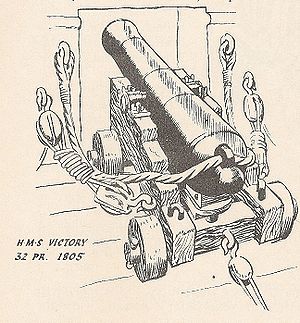
Below is a drawing and extract from ‘The story of the Gun’ Lt AW Wilson RA first published 1944:
‘The drawing shows a 32pr. on board the VICTORY. Compare it with any piece of 200 years before and notice the similarity. Elevation was still obtained by means of the quoin or wedge, while the only advance on checking recoil by means of ‘soft substance’ around the mast, seems to be that of anchoring the piece to the ship by a breeching passed through the eye of the cascable. The number in the detachments for these guns was decided by allowing one man for each 500lbs of metal. The 32-pounder weighed 32 cwt (3,584 lbs) and therefore had a crew of seven. It is interesting to consider that were we to use the same system today we should require a detachment of 70 for one of our modern heavy guns.’
The gun at Moulmein is marked as 17-1-0, indicating a weight of 17cwt 1 qtr and 0lbs. Which is a much lighter weight that might be expected for an approximately 9ft long, 32-pounder cannon. This is indicative of a carronade.
Carronades were a revolutionary concept in naval gunnery, known by the sailors as ‘Smashers’. They were first produced at the Carron Ironworks at Falkirk, Scotland, in 1770. They fired a 32lb. hollow shell filled with 500 musket balls. The idea was to approach enemy shipping from the rear and, aimed at the stern, the shell would explode on impact causing a shower of bullets to fly along the decks towards the bow, killing as many enemy crew and troops as possible. The ultimate 18th century naval anti=personnel weapon!
During the 2nd Burma War, Commodore Tarlton was in charge of the naval operations at the Battle of Martaban (on the opposite bank of the Salween River to Moulmein) and also at Pegu. His ship was HMS Fox. This ship was a vessel of 1,131 tons, built at Portsmouth in June 1821, re-fitted in September 1850, she was a 5th rate ship of the line, indicating a complement of 46 guns. On her quarterdeck she was armed with 10 32-pounder carronades, one of which corresponds exactly to the weight marked on the Moulmein piece.
Pair of Guns at Maymyo Forest Department
- widths="330px"
-
Cannon at Maymyo Forestry Dept view 1
Image courtesy of the Anglo-Burmese Library -
Cannon at Maymyo Forestry view 2
Image courtesy of the Anglo-Burmese Library
These neat bronze guns, cast at the East India Company’s gun foundry at Cossipore, in the district known as the 24 Purganas, not far north of Calcutta on the way to Barrackpore. They were cast by by Capt A Broome of the Bengal Artillery who was in charge of the foundry from 1846 to 1864. This pair of guns were cast in 1851, just at the beginning of the best period of his production, and would appear to be 9-pounders. They were undoubtedly cast for a small vessel of some sort, probably intended for mounting on the bow. These two most unusual guns have breeching loops - but underneath the buttons, which I have not seen before.
- widths="150px"
-
Breeching loop detail
Image courtesy of the Anglo-Burmese Library -
Button detail
Image courtesy of the Anglo-Burmese Library -
Casting date and place detail
Image courtesy of the Anglo-Burmese Library -
Date detail
Image courtesy of the Anglo-Burmese Library -
Founder and date detail
Image courtesy of the Anglo-Burmese Library
The 3rd Burma War was prosecuted using large gun vessels such as “IRRAWADDY” and “KATHLEEN”, barges, flats, small pleasure craft and the like, in order to move troops and equipment up river to complete the subjugation of Upper Burma. All these vessels carried guns of various calibres. “IRRAWADDY” did carry a 64-pounder carronade amongst other guns. One of the barges “WHITE SWAN”, is noted as being “bristling with guns”
Apparently the Maymyo cannon have been placed on carriages suitable for use on the railway.
The Mandalay Monster
- widths="330px"
-
Mandalay Monster
Image courtesy of the Anglo-Burmese Library -
Mandalay Monster detail
Image courtesy of the Anglo-Burmese Library
Without actual measurements it is difficult to calculate the poundage. Also we do not have a photo of the trunnion ends, which appear to be decorated. However this is clearly a cast iron gun. It is very roughly made native construction but with some input and advice from Europeans. I would imagine it is early 18th century. The interior of the muzzle is very interesting and the flaring appears to be decorative. The exterior of the muzzle seems to be simulated brickwork. It is unlike any other gun I have ever seen.
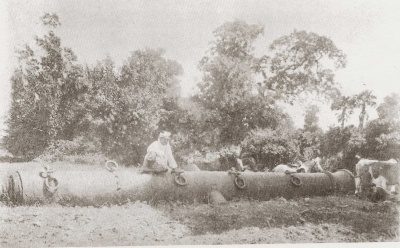
There is an account in the British Library IOLR- L/MIL/17/19/32/2; supplement to the History of the Third Burmese War 1885-1886. The Diary of Lt Henry Ernest Stanton, as follows:
"20th November 1885 AMARAPURA- Major Hewitt commanding Officer 1st Royal Artillery, with 100 men on reconnaissance. He found in the Old Palace enclosure 3 guns, 2 were broken and overgrown with grass. The third, of the same description as the others, was 30ft long 12” calibre and made of rings of iron, roughly welded together. The Burmese say these guns came from Arakan. They were left as they lay, being quite unserviceable.”
Another description comes from George W. Bird in his ‘Wanderings in Burma’ published in 1896. George Bird spent 20 years with the Education Department and his book, a series of different itineraries, is, in effect, the first guide book to Burma.
In ’Route XIV- Amarapura' pages 305 and 306…….
"Lying alongside of and half buried by the ruins of the campanile and the surrounding jungle, lies the enormous cannon captured from the Arakanese in 1784.
The principal dimensions taken by the writer from actual measurements are:- Exterior length 28ft 1in. Circumference below breech 9ft ins. At mouth 8ft 2ins. Calibre 11½"
The cannon is constructed of iron bars about 1½” square which run along the entire length. Round these bars lateral hoops or rings of similar bars are shrunk on and the whole welded together. Five pairs of enormous rings are welded onto the upper surface, apparently for the purposes of transport by means of long poles carried on men’s shoulders.
Lying in close proximity is another lesser size and of the same construction, and a few yards to the east buried in rubbish and jungle is a third, about 7 or 8 ft long with a calibre of about 16” which, from its chubby appearance, was probably a mortar for throwing shells or bombs."
These two descriptions are clearly of the same cannon although the measurements vary slightly. The photograph in George Bird’s book was taken by the famous war photographer Felice Beato who had finally settled in Mandalay and opened a curio shop. Finally the cannon was moved to the grounds of Mandalay Palace where the modern photograph was taken by Mr Mark Steevens.
The “ Monster” might have been a coastal defence weapon, especially if it came originally from the Arakan.

